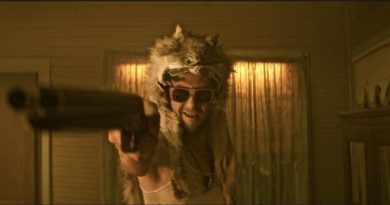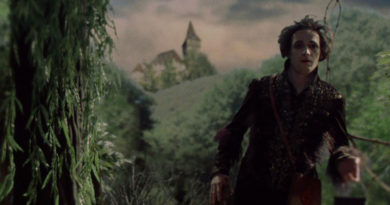David Cronenberg and the New Flesh
This is a repost from my old blog, Weird Movie Village, from 2010.
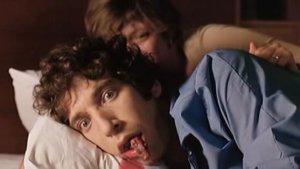
When I was 16, I saw David Cronenberg’s Shivers (aka They Came from Within) at the State Theater in South Bend, Indiana. It was my first exposure to the filmmaker’s work — and it was his first full-length feature as well.
Although I was too young to fully appreciate it at the time, I was certainly creeped out by the parallels between sexuality and disease, and this film introduced a different kind of zombie — one that doesn’t want to eat you but instead wants to screw you to death.
In the shocking opening scene, an older guy beats a very young-looking girl unconscious, throws her on a table, strips her naked, slices open her abdomen and pours acid inside her guts before slitting his own throat. And that’s just the first few minutes!
The seemingly crazed murderer was actually a physician in an exclusive gated luxury community who developed a parasitic creature he hoped would take over the functions of diseased organs in humans, but it instead acts as a powerful aphrodisiac and hallucinogen, transforming its hosts into ravening sexual animals who are also “turned on” by the invasion. The attack at the beginning of the film was actually the doctor’s attempt to quell the outbreak, but the promiscuous young girl already had encounters with other men in the building, and the infection spreads rapidly.

Cronenberg exploits the subject to make his audience as uneasy as possible. The parasites are passed from one host to another via bodily orifices. Legendary scream queen Barbara Steele receives hers in the bathtub before passing one through an open-mouthed kiss with comely neighbor Janine (Susan Petrie). Janine’s husband, Nicholas (Allan Kolman), is one of the guys who’d slept with the infected girl, and he’s reproducing the parasites rapidly. In one queasy scene, he lifts up his shirt and strokes his abdomen, practically cooing to the parasites as they ripple beneath his flesh.
Joe Blasco’s creatures and makeup effects are very well done, especially considering the film’s conservative budget. When Cronenberg hired him to work on the film, Blasco said he prepared for a career in horror makeup by working on the Lawrence Welk Show! The film is clammy and claustrophobic, and features the trademark bleak Cronenbergian finale — and it really gets under your skin.
Cronenberg’s fascination with mutated and transformed flesh continued with his next feature, Rabid (1977). Adult film star Marilyn Chambers takes a straight role as a young woman who develops a taste for human blood after receiving an experimental treatment at a mysterious clinic.
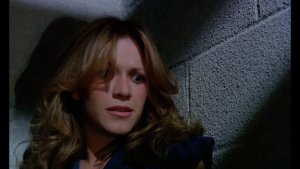
She’s been in a serious motorcycle accident, and the clinic’s head uses radiation-treated skin to graft to fire-damaged areas of her body. As a result, a barb-like appendage has grown under her arm, and she uses it to pierce the flesh of her victims and ingest their blood. She doesn’t kill them, but her “sting” causes them to contract a virulent form of rabies. The contagion quickly spreads, but she’s unaware that she’s the cause of it.
Chambers is quite good in her role, and although it doesn’t quite have the “ick” factor of Shivers, the film is better crafted and gives Cronenberg some opportunity to express his jet-black sense of humor. There’s a memorable scene at a shopping mall where cops shoot down Santa Claus while combating rabid shoppers!
The Brood (1979) stars Oliver Reed as a psychologist who is treating a patient with anger-management issues (Samantha Eggar) with unorthodox methods, causing her to give birth to vicious little mutant kids who attack and kill those who raise her ire.
It’s one of the most personal films he ever made. He’d recently undergone a painful divorce and then kidnapped his daughter because he feared his ex-wife had joined a lunatic cult. It’s a story that’s far more interesting than the film, which is a little too complicated in my opinion to be completely satisfying.
Scanners (1981) was a big hit for Cronenberg, opening the doors to Hollywood and allowing him to make Videodrome for Universal and The Dead Zone for Paramount, both released in 1983. Videodrome explores the idea of melding flesh and machinery, and though it’s high on kink, it’s too cold and complicated for me.
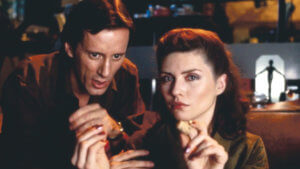
The Dead Zone proved that he could make a “straight” film based on the work of another (Stephen King), and it’s very good. Christopher Walken’s central performance is great, and an air of real melancholy hangs over every frame.
It’s interesting in that instead of mutated flesh, it features a mutated mind, as Walken’s character awakens from a two-year coma to find he’s acquired the gift (or curse) of telepathy. And a serial killer’s suicide near the beginning of the film should be mandatory viewing for today’s “torture porn” auteurs. It’s not particularly explicit, but it’s just…horrible.
After Zone, the Hollywood door opened even wider, and Cronenberg remade The Fly for 20th Century Fox in 1986. Here he was given a big budget and free reign to explore his themes of mutated flesh — and it was a huge hit! Giant actors Jeff Goldblum and Geena Davis are a perfect match, and the film is packed with his trademark grotesqueries.
As Goldblum’s Seth Brundle is mutating, he begins to lose his useless human body parts. In one memorable scene, he watches himself in the bathroom mirror as he pulls his teeth painlessly out of his mouth and then opens the medicine cabinet to reveal his redundant penis sitting on the shelf.
Dead Ringers (1988) stars Jeremy Irons as twin gynecologists Beverly and Elliot Mantle, who share sexual partners without said partners realizing there’s been a switch. When Beverly embarks on an affair with actress Claire Niveau (Genevieve Bujold), he becomes obsessed and doesn’t want to share her with Elliot.
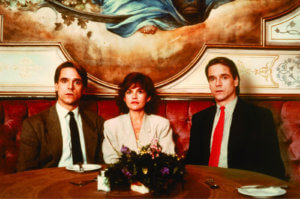
They’ve both had a lifelong fascination with the female reproductive system (hence their career), and the fact that Claire has a uterus divided into three separate chambers makes her irresistible to Beverly. Of course, it doesn’t take long for the psychological damage to occur, and soon Beverly is designing a set of “gynecological instruments for mutant women.”
Irons is magnificent as the twins, providing each with just enough difference in character to tell them apart. The word in Hollywood is that his later Oscar win for Reversal of Fortune was in fact a reward for this film, which was considered too “extreme” for nomination at the time. And Cronenberg’s gallows humor comes through in several scenes. Here, he manages to wrangle an outrageous plot, but keep it entertaining, comprehensible and…well, moving.
Next, Cronenberg tackled William S. Burrough’s “unfilmable” Naked Lunch (1991). Many have complained that the film is comprised of a series of seemingly unrelated scenes of bizarreness, but I’ve read the book and that’s what happens there, too! Peter Weller is the Burroughs surrogate and Judy Davis is his wife. He works as an exterminator, and she’s been shooting up his insect spray (“It’s a Kafkaesque high,” she says. “Makes you feel like a bug.”).
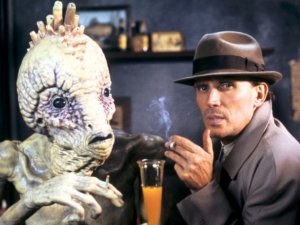
Exposure to the spray causes him to hallucinate that he’s an agent for Interzone Incorporated and has been assigned to assassinate her, initiating a descent into one of Cronenberg’s most outrageous visual forays yet. There are talking typewriters with particularly sensitive anuses, giant bugs, bizarre aliens and Roy Scheider in one of the strangest roles of his career. Lessons learned from his two previous films, he manages to wrangle the surrealism and absurdity of the novel into a bizarrely entertaining and funny film.
After M. Butterfly (which I frankly had no interest in seeing), Cronenberg embarked upon his most ambitious epic of weirdness yet — Crash (1996). Boasting a great name cast, including James Spader, Holly Hunter, Elias Koteas and Rosanna Arquette, it’s based on the J.G. Ballard novel and, as the tagline proclaims, it’s about “sex and car crashes.” It’s also his most successful work, in my opinion. It’s so sleek and shiny, the sex is intense, and his obsession with flesh melding with metal is eloquently communicated.
It’s also really, really funny. There’s just no way this film can’t be viewed as a black comedy. With every outrage, Cronenberg seems to be winking at the audience and saying, “You didn’t think I’d do this, did you?” And again, he gives the central figure the name of the original work’s author.

After James Ballard (Spader) survives a horrendous car crash, he enters into a sordid sort of sex club with similarly afflicted individuals, including the woman (Holly Hunter) he’d collided with.
Some time later, he’s in bed with his equally kinky wife (a terrific Deborah Kara Unger). She encourages him to talk about the genitalia of Vaughan (Koteas), another member of the “club.” Her verbiage is oddly clinical (“Imagine his anus,” she says. “Describe it to me.”).
Of course, Cronenberg follows this up with a vigorous sexual encounter between Vaughan and James in Vaughan’s convertible, which later becomes a penis surrogate itself when Vaughan uses it to ram James’ car.
And when Arquette’s character exposes a vagina-shaped wound in her thigh, which James can penetrate — and he does — it’s just too much. There’s also a scene in which Hunter is simultaneously massaging the crotches of Spader and Arquette while they’re watching car crash footage on television…whew. It’s certainly not a film for all tastes.
eXistenZ (1999) sounds disturbingly like one of those “lasting erection” pills, but it’s actually a film about a video game whose creator and marketer get trapped in. Starring Jennifer Jason Leigh and Jude Law, it’s not without its charms, but it’s kind of “Cronenberg lite.” It’s really a lark, but it’s well-done and entertaining, and there’s a lot of hilarious mutation.
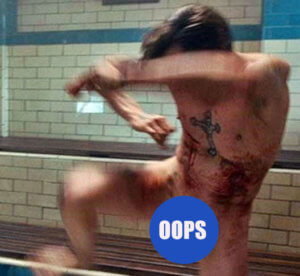
Lately Cronenberg has essentially become an arthouse director, and while I’ve admired some of these films — Eastern Promises, A History of Violence and Spider, I keep leaving the theater disappointed that they weren’t weirder. They certainly have audacious moments: Violence has a surprisingly explicit oral sex scene, and everyone still talks about Viggo Mortensen’s naked, brutal battle in Promises, but I just wish they were even more “out there.”
I’m optimistic that Cronenberg isn’t done yet, and I’m confident that he’s got another sticky, messy, wonderful opus to give to us. Unlike George Romero, who seems intent on delivering a bunch of not-very-interesting zombie films toward the end of his career, Cronenberg can give us something special.


